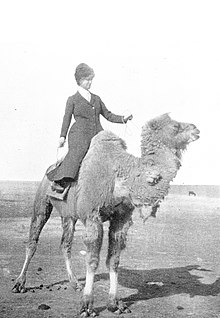
The Trans-Siberian Railway, historically known as the Great Siberian Route and often shortened to Transsib, is a large railway system that connects European Russia to the Russian Far East. Spanning a length of over 9,289 kilometers, it is the longest railway line in the world. It runs from the city of Moscow in the west to the city of Vladivostok in the east.

Ulaanbaatar, previously anglicized as Ulan Bator, is the capital and most populous city of Mongolia. It is the coldest capital city in the world, on average. The municipality is located in north central Mongolia at an elevation of about 1,300 metres (4,300 ft) in a valley on the Tuul River. The city was originally founded in 1639 as a nomadic Buddhist monastic centre, changing location 28 times, and was permanently settled at its current location in 1778.

The Tuvans or Tyvans are a Turco-Mongol ethnic group indigenous to Siberia who live in Russia (Tuva), Mongolia, and China. They speak Tuvan, a Siberian Turkic language. In Mongolia they are regarded as one of the Uriankhai peoples.

Nikolay Mikhaylovich Przhevalsky was a Russian geographer of Polish descent, and a renowned explorer of Central and East Asia.

Zhangjiakou also known as Kalgan and by several other names, is a prefecture-level city in northwestern Hebei province in Northern China, bordering Beijing to the southeast, Inner Mongolia to the north and west, and Shanxi to the southwest. By 2019, its population was 4,650,000 inhabitants on 36,861.56 square kilometres (14,232.33 sq mi), divided into 17 Counties and Districts. The built-up area made of Qiaoxi, Qiaodong, Chongli, Xuanhua, Xiahuayuan Districts largely being conurbated had 1,500,000 inhabitants in 2019 on 1,412.7 km2 (545.4 sq mi).
The Treaty of Kyakhta, along with the Treaty of Nerchinsk (1689), regulated the relations between Imperial Russia and the Qing Empire of China until the mid-19th century. It was signed by Tulišen and Count Sava Lukich Raguzinskii-Vladislavich at the border city of Kyakhta on 23 August 1727.

Kyakhta is a town and the administrative center of Kyakhtinsky District in the Republic of Buryatia, Russia, located on the Kyakhta River near the Mongolia–Russia border. The town stands directly opposite the Mongolian border town of Altanbulag. Population: 20,041 (2010 Census); 18,391 (2002 Census); 18,307 (1989 Census). From 1727 it was the border crossing for the Kyakhta trade between Russia and China.
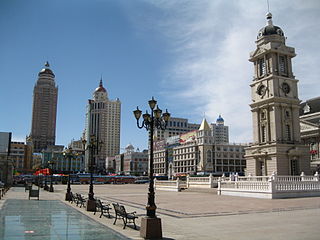
Manzhouli is a sub-prefectural city located in Hulunbuir prefecture-level city, Inner Mongolia Autonomous Region, China. Located on the border with Russia, it is a major land port of entry. It has an area of 696.3 square kilometres (268.8 sq mi) and a population of almost 250,000.
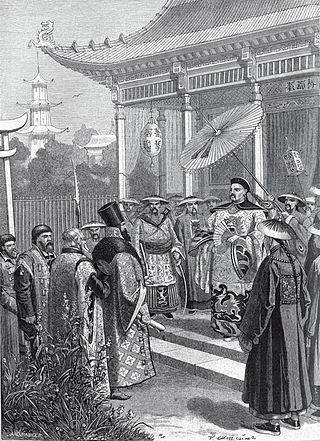
Prior to the 17th century, China and Russia were on opposite ends of Siberia, which was populated by independent nomads. By about 1640 Russian settlers had traversed most of Siberia and founded settlements in the Amur River basin. From 1652 to 1689, China's armies drove the Russian settlers out, but after 1689, China and Russia made peace and established trade agreements.

Captain John Dundas Cochrane was a Scottish officer in the Royal Navy, traveller and explorer. An illegitimate son of Scottish MP, army-commander and swindler Andrew Cochrane-Johnstone, John Dundas Cochrane came from extensive naval and army family - he was a cousin of Admiral Thomas Cochrane, 10th Earl of Dundonald, and nephew of Admiral Sir Alexander Forrester Inglis Cochrane.
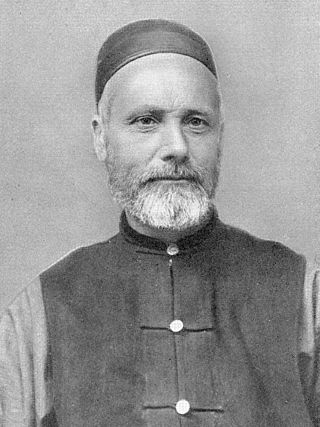
James Gilmour was a Scottish Evangelical Christian missionary in China and Mongolia. He served with the London Missionary Society.
Alice Mildred Cable was a British Protestant Christian missionary in China, serving with the China Inland Mission.
Frans August Larson was a Swedish missionary to Mongolia. He was the author of Larson, Duke of Mongolia which described time spent in Central Asia.

Buluqhan Khatun, also Bulughan, Bulukhan, Bolgana, Bulugan, Zibeline or Bolghara for Marco Polo, was a 13th-century Mongol princess, and the principal wife of the Mongol Ilkhanid ruler Abaqa (1234–1282).

The Mongolian Revolution of 1921 was a military and political event by which Mongolian revolutionaries, with the assistance of the Soviet Red Army, expelled Russian White Guards from the country, and founded the Mongolian People's Republic in 1924. Although nominally independent, the Mongolian People's Republic was a satellite state of the Soviet Union until the third Mongolian revolution in January 1990. The revolution also ended the Chinese Beiyang government's occupation of Mongolia, which begun in 1919. The official Mongolian name of the revolution is "People's Revolution of 1921" or simply "People's Revolution".

The Bogd Khanate of Mongolia was the government of Outer Mongolia between 1911 and 1919 and again from 1921 to 1924. By the spring of 1911, some prominent Mongol nobles including Prince Tögs-Ochiryn Namnansüren persuaded the Jebstundamba Khutukhtu to convene a meeting of nobles and ecclesiastical officials to discuss independence from Qing China. On 30 November 1911 the Mongols established the Temporary Government of Khalkha. On 29 December 1911 the Mongols declared their independence from the collapsing Qing dynasty following the outbreak of the Xinhai Revolution. They installed as theocratic sovereign the 8th Bogd Gegeen, highest authority of Tibetan Buddhism in Mongolia, who took the title Bogd Khan or "Holy Ruler". The Bogd Khaan was last khagan of the Mongols. This ushered in the period of "Theocratic Mongolia", and the realm of the Bogd Khan is usually known as the "Bogd Khanate".
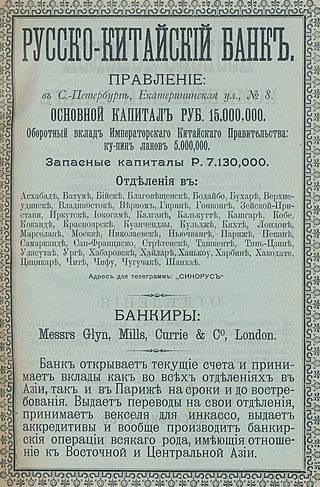
The Russo-Chinese Bank was a foreign bank, founded in 1895, that represented joint French and Russian interests in China during the late Qing dynasty. It merged in 1910 with the French-sponsored Banque du Nord, a large domestic bank in Russia, to form the Russo-Asiatic Bank.

The Mongolia–Russia border is the international border between Mongolia and the Russian Federation. It runs from west to east between the two tripoints with China for 3,452 km (2,145 mi). The boundary is the third longest border between Russia and another country, behind the Kazakhstan–Russia border and the China–Russia border.

Sarah Marquis is a Swiss adventurer and explorer. From 2010 to 2013, she walked 20,000 kilometres (12,000 mi) alone from Siberia to the Gobi Desert, into China, Laos, Thailand, and then across Australia. In 2011, she gave a TED talk and in 2014 she was named one of National Geographic's Adventurers of the Year.

The Kyakhta Trade refers to the trade between Russia and China through the town of Kyakhta on the Mongolian border south of Lake Baikal from 1727. The trade was mostly Siberian furs for Chinese cotton, silk, tobacco and tea.
